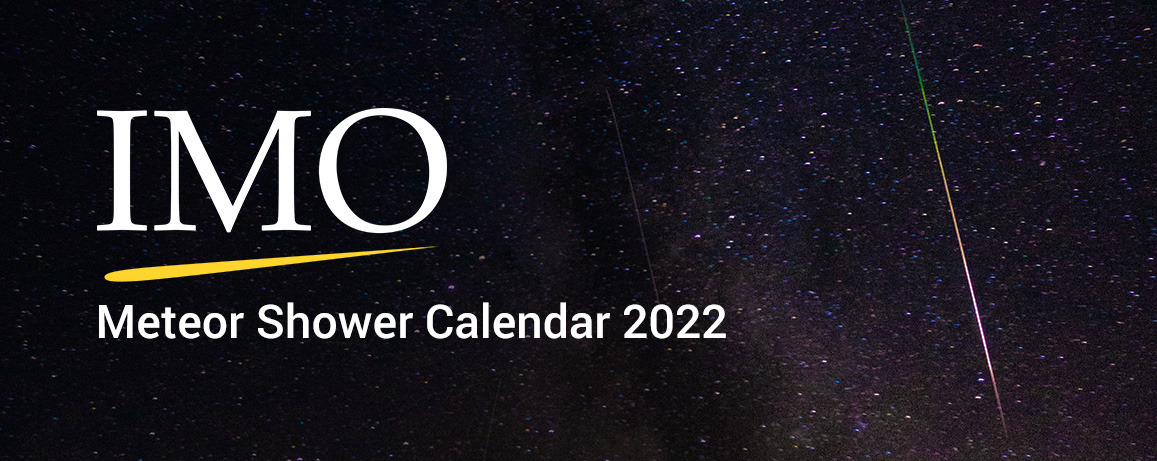
The 32nd International Meteor Organization Meteor Shower Calendar is available!
The main intention of the annual International Meteor Organization Meteor Shower Calendar is to draw the attention of observers to regularly returning meteor showers as well as to provide information about events which may be possible according to model calculations. This includes both the possibility of extra meteor activity in terms of additional peaks and/or enhanced rates but also the observational evidence of no rate or density enhancement. Both may help to improve our knowledge about the numerous effects and interactions between meteoroid parent objects and the streams. Further, the Calendar hopefully continues to be a useful tool to plan your meteor observing activities.
2022 Highlights
- For the three strongest annual shower peaks in 2022 we find moonless skies for the Quadrantids, almost full Moon for the Perseids and waning gibbous (near last quarter) Moon for the Geminids. Good conditions for the maxima of other well-known showers are found for the maximum period of the η-Aquariids, Southern δ-Aquariids Aurigids and the Ursids.
- The available predictions for 2022 include a potential outburst of the Tau Herculids on May 31, a shower which is at or below the detection threshold at least for visual observers in other years.
- Meteoroids released from the minor planet 2006GY2 may cause activity on May 15 near
10h20mUT (λ = 54.28◦). According to Vaubaillon (2021) it is a dense stream and worth watching in that period (the density of asteroidal streams is difficult to estimate). The expected radiant is at α = 248◦, δ = +46◦ which is about 3◦ east of the star τ Her (not to be mixed up with the TAH shower); velocity 36 km/s. - Full Moon on August 12 will badly affect optical observations of the Perseid (007 PER) activity
around their maximum. The timing of the nodal maximum at λ = 140.0◦ (2022 August 13, shortly after 01h UT) favors west European locations. - The Geminids reach their broad maximum on December 14 centered at 13h UT, this time only six days after full Moon. A wide range of observing conditions for visual observers may allow us to obtain data which can be used for testing correction procedures.
The heart of the Calendar is the IMO Working List of Visual Meteor Showers which is continuously updated so that it is the single most accurate listing available anywhere today for visual meteor observing. Nevertheless, it is a Working List which is subject to further modifications, based on the best data we had at the time the Calendar was written. Observers should always check for later changes noted in the IMO’s journal WGN or on the IMO website. Vice versa, we are always interested to receive information whenever you find any anomalies! To allow for better correlation with other meteor shower data sources, we give the complete shower designation including the codes taken from IAU’s Meteor Data Center listings.




 You saw something bright and fast? Like a huge shooting star? Report it: it may be a fireball.
You saw something bright and fast? Like a huge shooting star? Report it: it may be a fireball.  You counted meteors last night? Share your results with us!
You counted meteors last night? Share your results with us!  You took a photo of a meteor or fireball? You have a screenshot of your cam? Share it with us!
You took a photo of a meteor or fireball? You have a screenshot of your cam? Share it with us!  You caught a meteor or fireball on video? Share your video with us!
You caught a meteor or fireball on video? Share your video with us!
3 comments
This is great info! Thank you very much!
Thank you for the great information!
I like this web page. There are something’s I’ll never understand but better to know something’s,rather then know nothing at all. Thank you for keeping us informed about what’s going on in our skies and also letting us learn from you. I honestly think I have learned something everytime I have read you work. So thank you for teaching us. So please keep doing what you do so we can benefit from your teaching.
Sincerely,Julie A. S.